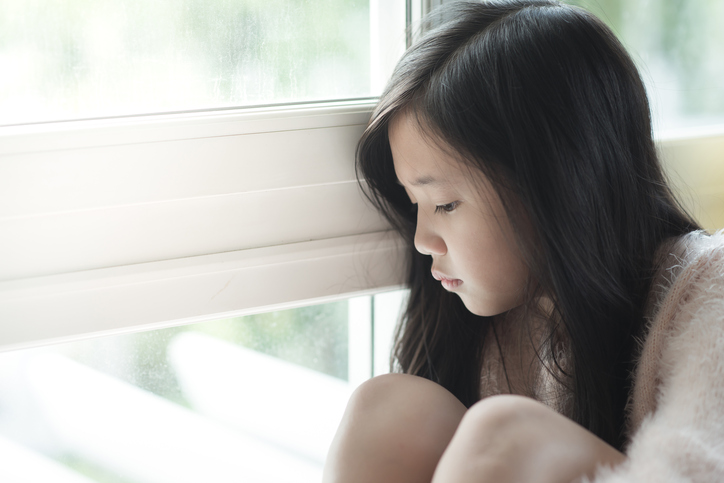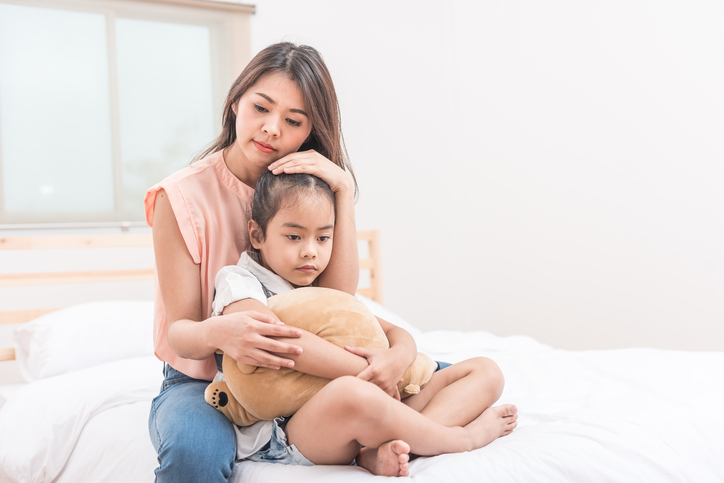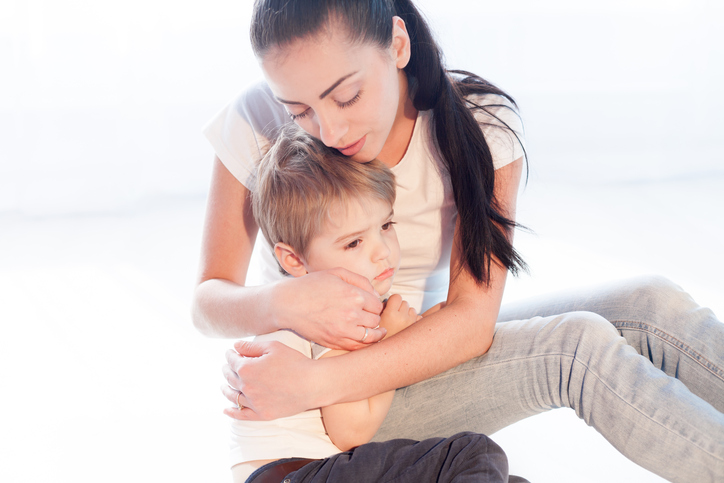It’s time to head to a classmate’s birthday party when your child starts to get that familiar look of panic you’ve come to recognize.
Your little one looks like they’re about to burst into tears and says, “I don’t want to go anymore. Don’t make me go. I don’t feel good.” And you know the anxiety is back.
What should be a fun day of ice cream, cake, and friends has been turned into a scary danger zone by your child’s mind. You’re probably wishing you had some tips for helping kids with anxiety you could pull out of your bag right about now.
“Being the parent of an anxious child can be a roller coaster. While anxious children are often thoughtful and caring, they can also be exasperating and place extra demands on parents in terms of time and emotion.”
– Ronald Rapee, PhD and author of, Helping Your Anxious Child: A Step-By-Step Guide For Parents
Your first impulse might be to just skip the party all together in order to avoid causing your child any pain.
And while your intentions are good, trying to protect chronically anxious kids from triggering events often backfires and further exacerbates their worries.
There is no one-size-fits-all solution for helping kids with anxiety, but there are several research-based techniques your child can use to help manage it.
RELATED: Anxiety In Children: 19 Things Every Parent Should Know
The good news? These coping skills aren’t hard to learn.
Here are 9 useful tips for helping kids with anxiety.
By working on these skills, you can help your child face their fears and focus on the positives so they can participate more fully in the fun experiences of childhood.

Tips For Helping Kids With Anxiety
1. Don’t Completely Avoid Things That Cause Anxiety
Helping kids with anxiety doesn’t mean helping them avoid things they’re afraid of.
This may make them feel better in the short term, but in the long run avoidance ends up reinforcing anxiety even more. Not what you’re trying to accomplish.
Instead of avoiding worrisome situations all together, try something called laddering. This is where you break down the scary activity into smaller, manageable chunks.
So if you’re child is afraid of getting in a swimming pool, for example. Start by having them simply sit at the edge of the pool.
Next you might have them put their feet in the water, then sit on a step in the shallow end, and gradually progress until they are all the way in the water.
Kids feel safer when they approach an overwhelming task in smaller, less threatening steps.
RELATED: The Secret To Raising A Confident Child
2. Set Realistic Expectations
You can’t promise a child they won’t lose a game, or fall off a bike, or not get invited to a party. Those things may very well happen.
But you can be positive and express confidence that your child will be able to handle whatever does happen, and that they’ll be okay.
Helping kids with anxiety is about showing them how facing their fears and doing what they’re afraid will actually lower their anxiety levels over time.
3. Validate, But Don’t Amplify Feelings
Validation isn’t the same thing as agreement. If your child is scared of the dentist, you don’t want to disregard those feelings, but you don’t want to amplify their fears either.
Listen and be empathetic, while encouraging your child to face what frightens them.
RELATED: Raising An Emotionally Intelligent Child
“I know you’re scared of the dentist and that’s okay, but taking care of your teeth is important. Dr. Smith is a really nice man and I’m here to help you get through this.”
4. Don’t Frame Worry As A “Bad” Thing
Anxiety is hard enough without attaching negative labels to it.
Don’t talk in terms of “good” or “bad”, because that can lead your anxious child to think, “I’m not normal” or “something must be wrong with me”.
Kids can develop anxiety about having anxiety, which only makes the worrying worse.
Teach your kids that worrying is a protection mechanism built into humans since we were running away from dinosaurs. It helped us survive danger!
It’s also totally normal, and everyone worries at some point.
But sometimes our old dinosaur protection system sets off false alarms, and we worry about things we don’t need to.
This is what causes anxiety. Today, we can stop anxiety with some tricks that I can teach you (see 5-9 below).

5. Stop Reassuring
If you’ve got a worrisome child, you probably already know that reassurance falls on deaf ears.
“There is nothing to be afraid of, trust me.”
Yea right. How many anxious kids hear that and instantly let go of their fear? None.
During periods of heightened anxiety, your child experiences a dump of chemicals into their body putting them in fight-or-flight mode. They are in no position to think analytically or listen to your reassuring words.
Instead of trying to reassure or rationalize with your child, try a more basic calming technique instead.
Related: Amazing Benefits Of Teaching Mindfulness To Children
Stop, take a few deep breaths with your child and let the initial fear reaction pass. Then listen and empathize.
Once they are calm, start talking about possible ways to manage whatever task your child is afraid of (like laddering, above).
6. Ask Open-Ended Questions
You want to encourage your child to talk about their feelings without asking leading questions like, “are you worried about your test today?”
This can feed the anxiety cycle and make it worse.
Instead ask open-ended questions like, “How do you feel about the test today?”
This gets the conversation started without focusing on the fear.
7. Encourage ‘Accurate’ Thinking
Anxiety often springs from exaggeration. The best solution for distorted thinking is not positive thinking, it’s accurate thinking.
Helping kids with anxiety means helping kids think more accurately.
If your child is using words like “all”, “never”, or “no one” have them examine that thought to see if it’s really true.
“No one likes me.” Did someone sit with them at lunch? Did a friend play with them at recess?
Sometimes when you look at fact-based evidence, instead of just feelings, it becomes clear that their anxious thoughts are not accurate.
Another form of inaccurate thinking that exacerbates worry is future-thinking. Anxious kids often get caught up in “what if” thinking spirals.
“What if nobody plays with me at recess?” “What if I someone laughs at me?” What if…what if….
Research shows that teaching kids to embrace “what is” thinking and come back into the present moment can help stop these negative thought spirals.
One way to do this is by practicing mindfulness exercises with your kids.
RELATED: Bring Calm To Chaos: 6 Simple Mindfulness Exercises For Kids
8. Set Aside Worry Time
As you already know, telling your child not to worry isn’t going to stop them from doing so.
Trust us when we say if your kids could turn off their anxiety, they would.
But sometimes allowing kids to express their worries openly, in a controlled way, can help them work through their fears.
To that end, it may be helpful to set aside a regular “worry time”. Maybe it’s 10 – 15 minutes after dinner or before bed where your child can write out their worries (or speak them if they’re too young to write).
During worry time any fear can be expressed and brought out into the open.
Then when the allotted time is up, the worry book is closed and it’s time to let go of the day’s anxieties.
This can give kids a release valve for their fears.
RELATED: 7 Ways To Ease Back To School Anxiety
9. Create An Anxiety Checklist
What do astronauts, soldiers, and pilots do when faced with a emergency situation?
They don’t just make stuff up as they go…they refer to their emergency checklist!
When you’re anxious and stressed, it’s hard to think straight. That’s why people in dangerous positions have checklists in the first place.
Helping kids with anxiety can be similar.
Make a checklist of things they can do to help themselves calm down when they feel panic coming on. Things that work for them.
It could be tapping, or breathing, or standing in place, or having a code word to tell you…whatever it is, write down the steps and have your child practice, like an emergency anxiety drill.
This way they’ll be more prepared to handle the real thing when it happens.
RELATED: Amazing Children’s Books About Anxiety Help Overcome Worries
Watching your child suffer from worry can be painful, frustrating, and confusing.
Helping kids with anxiety doesn’t mean removing the stressors that trigger it, it means helping them learn to tolerate and manage their fears as best they can.
It also means teaching them to take action, in spite of their anxiety.
As a result, your child will start to see that they are able to move past their fears, and their anxiety will likely decrease over time.
*Note: If your child’s anxieties and fears do not dissipate over time, or you feel their health and/or quality of life is being impacted by worry, then you should consult with your healthcare provider or a licensed child therapist for additional child anxiety treatment options.
The Association for Behavioral and Cognitive Therapies (ABCT) website contains a directory of providers (www.abct.org).
SHARE 9 tips for helping kids with anxiety on Facebook and Pinterest by clicking the buttons below.












